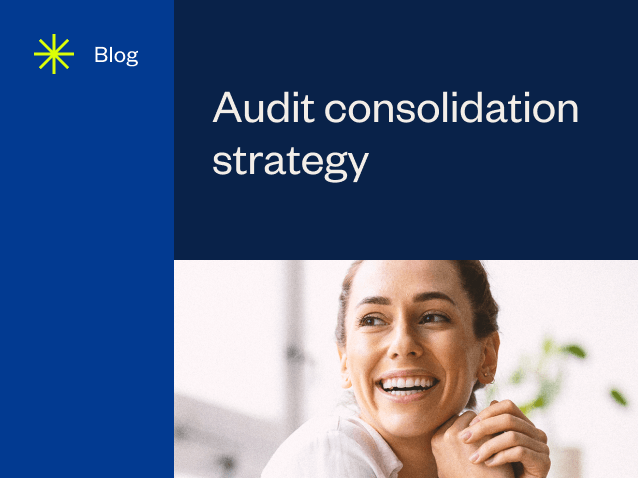Simplify Compliance With an Audit Consolidation Strategy

With the cost of cybercrime predicted to hit $10.5 trillion by 2025, many organizations consider enhancing their cybersecurity programs a top priority. One of the most surefire ways to find gaps in protection comes from completing multiple security audits. But with so many potential audits to pursue, it can be difficult to manage multiple workstreams and keep track of varying control elements.
Audit consolidation — or, conducting audits in tandem as a singular annual event — is one way that organizations can maximize efficiency.
Our 2022 Compliance Benchmark Report takes a deeper look into organizations’ views on audit consolidation. We surveyed more than 700 cybersecurity, IT, quality assurance, internal audit, finance, and other professionals about their audit programs to gain a better understanding of their organization’s position on minimizing risk and maximizing efficiency.
One of the biggest findings we uncovered during our research is that even though 85% of organizations conduct more than one audit every year, only 15% of the same organizations have consolidated their audits down to a single, annual event.
Frequent audits can be costly and time-consuming, and some industries would highly benefit from audit consolidation. Our survey found that 37% of IT organizations conduct 4-5 audits per year. We also found that 30% of finance organizations and 35% of government organizations conduct 6 or more audits annually.
By consolidating the auditing process, organizations can work more efficiently, freeing up resources to focus on other aspects of the business. But despite these benefits, not all organizations prioritize streamlining their audit programs.
Consolidation efforts vary by industry
Our survey results found an interesting pattern: certain industries tend to consolidate audits more than others. The healthcare industry is particularly savvy when it comes to audit consolidation, with almost a quarter of healthcare organizations (24%) consolidating audits into a single annual event. This is an increase of 6% from last year, pushing the industry from one of the lowest adopters of audit consolidation to the sector with the highest adoption. With healthcare providers seeing a 117% increase in website/IP security alerts due to malware in the past year, it’s not surprising to see a greater emphasis on security audit efficiency.
The professional services industry now has the lowest percentage of audit consolidation, hovering at 8%.
Audit consolidation minimizes stress
The audit process can be exhausting. Many staff members are often forced to step away from their normal daily responsibilities in order to ensure accurate results during an audit, which requires significant time and energy from every party involved. This reduction of working time can hinder the productivity of the organization.
When asked about the greatest challenge of their audit process, organizations’ top responses were:
- Limited staff resources (27%)
- Tedious and manual evidence collection (21%)
- The complexity of multiple audits (16%)
Even with their challenges known, organizations may still struggle to find solutions. A useful tool for assisting consolidation efforts is compliance management software. This software is capable of:
- Deduplicating evidence collection efforts, allowing organizations to upload a piece of information once and use that information across multiple audits.
- Cross-walking, which is the ability to see how close an organization is to completing additional audits based on the work completed for a current audit.
- Centralizing Evidence Collections, which saves time by uploading evidence before fieldwork with one-click batch processing.
Automation tools and audit consolidation can help minimize internal disruptions, along with eliminating redundancies and identifying gaps in coverage.
Consolidating audits with a Master Audit Plan
The best way to consolidate your audits is by using a master audit plan (MAP). These detailed plans provide an organization with a more effective approach to the auditing process, offering a clear view of scoping, timing, and internal rhythms.
A-LIGN has a systematic and strategic 4-step approach to building MAPs for organizations and helping them complete audit requirements. A-LIGN will:
- Review current practices and define the audit scope
- Create customized timeline recommendations and identify areas of improvement
- Determine and confirm a holistic audit approach
- Deliver an efficient, collaborative, and scalable audit program
Paired alongside A-LIGN’s A-SCEND audit management platform, a MAP can simultaneously consolidate your organization’s audits while also minimizing expenses and improving productivity.
Start building your own MAP
Although organizations usually complete at least one audit per year, there is no limit for the number of audits that can be completed. However, if your organization conducts more than one audit per year, creating and implementing your own MAP is a strategic investment that will save you time and money.
A-LIGN works with organizations throughout the entire audit process. Our team of experts ensures your MAP grows with your business and operates as a living document that is continuously updated to reflect the evolution of your audit process.
Equip your organization with a MAP to efficiently consolidate audits. Contact one of our experts to get started.
